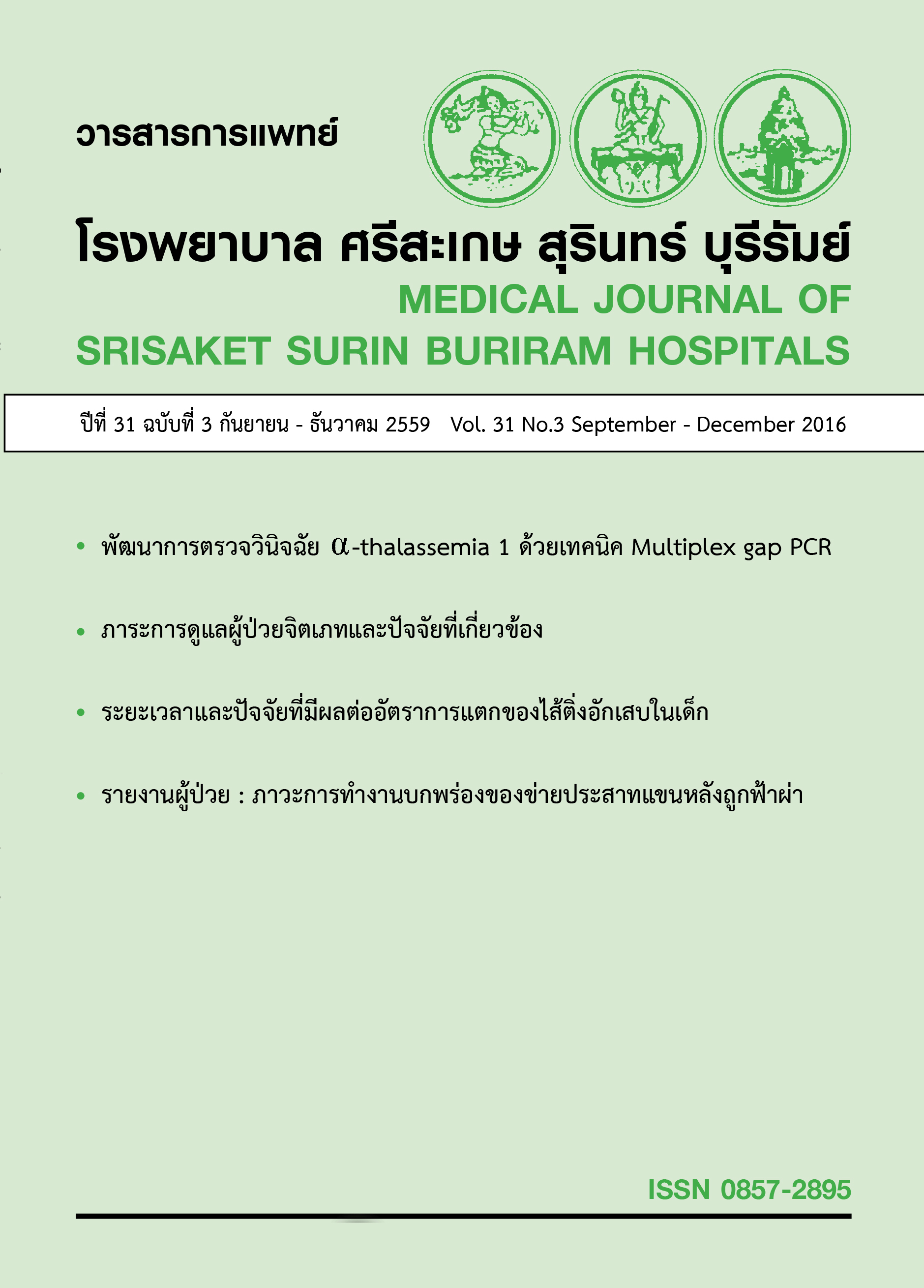รายงานผู้ป่วย : ภาวะการทำงานบกพร่องของข่ายประสาทแขนหลังถูกฟ้าผ่า
Main Article Content
บทคัดย่อ
รายงานผู้ป่วยหญิงไทยอายุ 27 ปี มารับการตรวจรักษาที่โรงพยาบาลบุรีรัมย์ ด้วยถูกฟ้าผ่าและมีภาวะหัวใจหยุดเต้น หลังจากรักษาตัวในโรงพยาบาลเป็นเวลา 7 วัน ผู้ป่วยรู้สึกตัวมากขึ้น ตรวจพบอาการอ่อนแรง ตั้งแต่กล้ามเนื้อไหล่, แขน ลงมาจนถึงมือทั้งหมด ทั้งสองข้าง ตรวจ Magnetic resonance imaging (MRI) of cervical spine พบ hyperintense signal ใน T2 weighted image (T2WI) ที่บริเวณข่ายประสาทแขนทั้งหมด (total brachial plexus) ทั้งสองข้างตรวจ nerve conduction velocity study และ electromyography แปลผลเป็น incomplete bilateral brachial plexopathy รูปแบบ total arm type และได้รับการวินิจฉัย เป็นภาวะการทำงานบกพร่องของข่ายประสาทแขนหลังถูกฟ้าผ่า (Brachial plexopathy following lightning) ซึ่งเป็นภาวะแทรกซ้อนที่พบได้น้อยมาก ในรายงานนี้อธิบายเกี่ยวกับพยาธิกำเนิด ลักษณะภาพทางรังสีวิทยา การวินิจฉัยแยกโรค รวมถึงแนวทางการรักษา
Article Details
References
2. Ashis P, Ashok KM, Menka J. Panbrachial plexus neuropraxia following lightning: A rare case report. Surgical neurology international 2015; 6 Suppl 2:S110-12.
3. Bhargava AN, Kasundra GM, Khichar S, Bhushan BS. Lightning strike-induced brachial plexopathy. J Neurosci Rural Pract 2014;5(4):399-400.
4. Cherington M, Yarnell PR, London SF. Neurologic complications of lightning injuries. West J Med. 1995;162(5):413-7.
5. Vasileios I. Sakellariou, Nikolaos K. Badilas, George A. Mazis, et al. Brachial Plexus Injuries in Adults: Evaluation and Diagnostic Approach. ISRN Orthopedics, vol. 2014 [Internet]. 2014 [cited 2016 Jan 5]; Article ID 726103, 9 pages. Available from: https://www.hindawi.com/journals/isrn/2014/726103/cta/
6. Addar AM, Al-Sayed AA. Update and review on the basics of brachial plexus imaging. Med Imaging Radiol. 2014;2(l):l-9.
7. Lawande M, Patkar DP, Pungavkar S. Pictorial essay: Role of magnetic resonance imaging in evaluation of brachial plexus pathologies. Indian J Radiol Imaging 2012;22(4):344-9.
8. Mansukhani KA. Electrodiagnosis in traumatic brachial plexus injury. Ann Indian Acad Neurol 2013; 16(1): 19-25.
9. Silbermann-Hoffman O, Teboul F. Post-traumatic brachial plexus MRI in practice. Diagn Interv Imaging 2013;94(10): 925-43.
10. Tharin BD, Kini JA, York GE, Ritter JL. Brachial plexopathy: a review of traumatic and nontraumatic causes. AJR Am J Roentgenol 2014;202(1):W67-75.
11. Vijayasarathi A, Chokshi FH. MRI of the brachial plexus: A practical review. Appl Radiol 2016;45(4):9-18.
12. Yoshikawa T, Hayashi N, Yamamoto S, Tajiri Y, Yoshioka N, Masumoto T, et al. Brachial plexus injury: clinical manifestations, conventional imaging findings, and the latest imaging techniques. Radiographics 2006;26 Suppl 1:S133-43.

